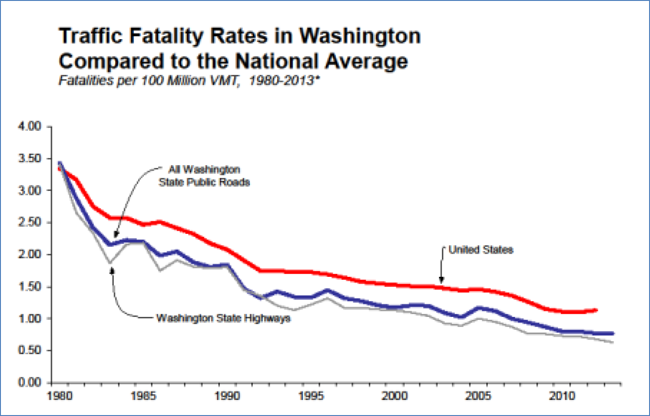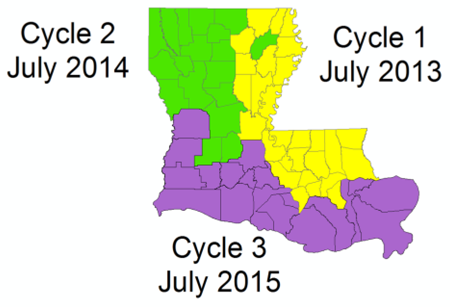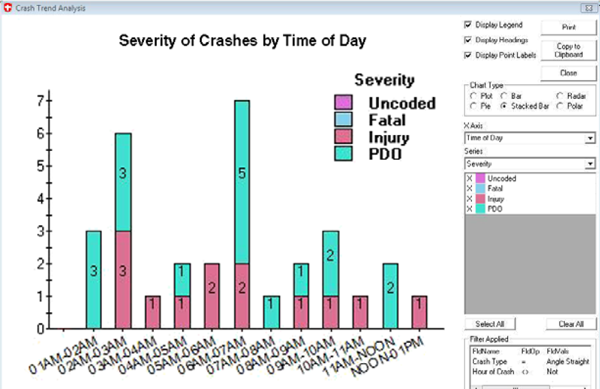Background
Louisiana Department of Transportation and Development (DOTD) established a Local Roads Safety Program in 2006 and despite early barriers and challenges, it has become a viable program aimed at improving highway safety on Louisiana's local road network. Today, the Louisiana Local Technical Assistance Program (LTAP) Center administers the Local Road Safety Program and DOTD sets aside $3 to $5 million from its Section 154 and 164 Safety Transfer funds, Highway Safety Improvement Program (HSIP) funds, and High Risk Rural Roads Program (HRRRP) funds for local safety projects. (Note: MAP-21 continues two penalty transfer programs to encourage States to enact Open Container laws (Section 154) and Repeat Intoxicated Driver laws (Section 164). Any State that does not enact and enforce a conforming open container and repeat intoxicated driver law will be subject to a penalty transfer of funds. Additional information is available on the MAP-21 Guidance page.) Thanks to the successful partnership between LTAP and DOTD, technical assistance and funding is available to help local agencies implement infrastructure projects.
Within DOTD, no unit or department is responsible for administering local road safety projects, which is one of the main reasons for the partnership with LTAP. The DOTD Office of Safety provides funding to LA LTAP for a full-time traffic safety engineer/program manager, a part-time project engineer and two part-time traffic safety engineers.
The main component of the Louisiana LTAP program is to help local agencies develop the capability to solve local road safety problems using local resources or by accessing funds through the Strategic Highway Safety Plan (SHSP) process. LTAP assists local agencies to identify, apply for, and administer local road infrastructure safety projects. Most recently, they have begun to assist the regional transportation safety coalitions with the identification and implementation of infrastructure improvements.
In 2011, DOTD divided the State into 10 regions and charged each with developing a regional safety coalition and a safety plan (a regional SHSP) to help with the implementation of the Louisiana SHSP. Each coalition reviews regional crash data to identify strategies and projects to reduce fatalities and serious injuries for impaired drivers, unbelted drivers, young drivers, and infrastructure-related crashes. LTAP works with the coalitions to identify and implement local infrastructure improvements for the plans in coordination with activities on the State system.
Benefits
To date, LTAP has provided local data, data analysis, and technical assistance to four regional coalitions. The most advanced coalition, the South Central Regional Transportation Safety Partnership, has conducted five Road Safety Audits (RSAs), and with the help of LTAP is preparing to apply for funding. LTAP also currently is working with coalition members (as well as individual parishes) to implement a system-wide/systemic approach to improving safety on horizontal curves. LTAP has located all horizontal curves on the local road system. LTAP is working with the local agencies and DOTD to develop a process to characterize and prioritize these curves based on certain criteria and to develop a manageable process to implement projects systemically.
In terms of next steps, LTAP, LSU, and DOTD are partnering on a three-year program to assemble roadway and traffic data on the local road system. This program will collect roadway characteristic and traffic data on all arterials, collectors and roads of significance for the local road system. This will continue to enhance LTAP's capability to work with the local agencies, share data, and collaborate on infrastructure improvements. LTAP is facilitating the development of a research project to develop better estimates of local road Annual Average Daily Traffic (AADT) which is necessary for many of the analytical tools currently being used to analyze for safety.
Contact
FHWA Office of Safety staff contacts by safety function



